Results matching “Bird”
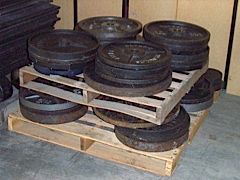 This is the third in this month's article series on strength training equipment - a collaboration with Run to Win's Blaine Moore. Today I'll be looking at a few of the essentials for any gym - bars, plates, hooks and collars.
This is the third in this month's article series on strength training equipment - a collaboration with Run to Win's Blaine Moore. Today I'll be looking at a few of the essentials for any gym - bars, plates, hooks and collars.
Standard vs Olympic
When I began lifting weights - a little under 3 years ago now, although I gave them a few brief tests a decade or two ago - I started the home gym off with a bench, bar, dumbbells and plates. These bars were standard (rather than Olympic); as were all of the plates.
It was not until several months later I became aware of the differences, and began switching over to Olympic bars and plates. So what are the differences?
There are six key differences between Standard and Olympic plates. If you're aiming to compete in a powerlifting or Olympic lifting event, the Olympic bars and plates are an obvious choice. However, they may still be worth considering for their other differences. These are :
diameter (of hole, bar) : Standard bars are less than 1" in diameter, whilst Olympic bars are a more noticeable 2" or so. This instantly increases the grip component of many lifts.
length (of bar) : a Standard bar measures either 5', 6' or 7' (the 6' seems to be the most common); an Olympic one is always 7'. The extra length increases the stabilisation component of many exercises.
weight (of bars) : a Standard bar weighs in at around 10kg, an Olympic one a much heftier 20kg. The weight of an Olympic bar is easily included in calculations for total weight, as it equals the same as a large (20kg) plate. Whilst there are both heavier and lighter plates available, the 20kg (44lb) is common.
cost : the major factor in the favour of Standard bars and plates is the cost, which is generally considerably cheaper than the Olympic counterparts.
comparison : for both calibration and historical reasons it is usual to see Olympic bars and plates used in competition. However, even if you're not competing, it's great to be able to instantly compare your own lifts to those you've seen on the platform.
threading and knurling (of bars) : Standard bars often have threaded ends (for the collars), whilst Olympic bars are typically smooth throughout this section. Olympic bars also differ in the knurling on the bar, which is similar from bar to bar, unlike the knurling on Standard bars. This knurling is used not only for grip, but to line your body up in various exercises.
availability : another factor that should be considered when purchasing new bars or plates is their availability. Both new and second-hand bars and plates are more easily found in Standard sizes. When it comes to buying plates - particularly at this time of year - a great place to start is the nearest garage sale. Joe Skopec has a great article on cleaning up the rusty iron you often come across in such a sale.
Fat bars
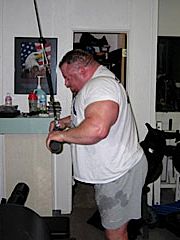 If you're looking for a little more of a grip challenge than an Olympic bar affords, consider either making or purchasing a fat bar. A typical diameter of a fat bar is 2.5' - 3'.
If you're looking for a little more of a grip challenge than an Olympic bar affords, consider either making or purchasing a fat bar. A typical diameter of a fat bar is 2.5' - 3'.
One thing to keep in mind - especially if you're fattening up your own bars - is that the plates themselves will be unchanged (whether Standard or Olympic); only the bar itself will be altered. For a very simple way of doing this, take a look at a couple of pictures of my chinning bar being given the fattening treatment. A similar process was then employed to thicken up a couple of dumbbell handles.
Hooks
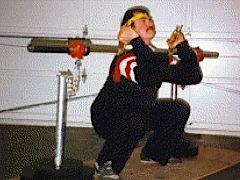 If you've ever tried Front Squatting, you may have considered using the Hook method. This is the DIY gym enthusiast's version of the Top Squat device; employing two pipe wrenchs or long-handelled vices to hold the bar as pictured.
If you've ever tried Front Squatting, you may have considered using the Hook method. This is the DIY gym enthusiast's version of the Top Squat device; employing two pipe wrenchs or long-handelled vices to hold the bar as pictured.
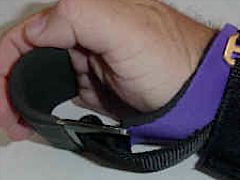 Other hooks sometimes used in conjunction with the bar are those which are connected to wrist straps (the 1-Ton Hooks are perhaps the best known), and reduce the grip component on lifting exercises such as shrugs, rows and the deadlift.
Other hooks sometimes used in conjunction with the bar are those which are connected to wrist straps (the 1-Ton Hooks are perhaps the best known), and reduce the grip component on lifting exercises such as shrugs, rows and the deadlift.
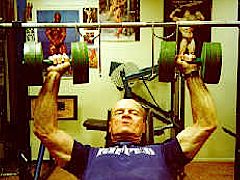 For dumbbell pressing exercises when a spotter is not present, Dumbbell Hooks (usually Power Hooks) are invaluable. These allow the bells to be suspended close to the starting and finishing position of the exercise, and remove the need to hold the dumbbell as you get into position.
For dumbbell pressing exercises when a spotter is not present, Dumbbell Hooks (usually Power Hooks) are invaluable. These allow the bells to be suspended close to the starting and finishing position of the exercise, and remove the need to hold the dumbbell as you get into position.
 Via Napalm's Corner : video of Chris Muir [13.8mb, .wmv] - the Diesel Athlete of the month - enjoying a few reps with a 380lb stone. Not bad at all.
Via Napalm's Corner : video of Chris Muir [13.8mb, .wmv] - the Diesel Athlete of the month - enjoying a few reps with a 380lb stone. Not bad at all.
 Eric Talmant delivers the second part of his Metabolic typing (part 1) series on EliteFTS. Very interesting.
Eric Talmant delivers the second part of his Metabolic typing (part 1) series on EliteFTS. Very interesting.
 Watch the guys from 3Run enjoying a bit of free running (streaming, 8.97mb .flv) around London. Excellent stuff.
Watch the guys from 3Run enjoying a bit of free running (streaming, 8.97mb .flv) around London. Excellent stuff.
 Another sweat-filled week here on Straight to the Bar (it reached 43C/109F yesterday). In between rounds of lifting and relaxing dips in the pool, the following appeared :
Another sweat-filled week here on Straight to the Bar (it reached 43C/109F yesterday). In between rounds of lifting and relaxing dips in the pool, the following appeared :
- Several new training blogs : including Ken's Kettlebell Blog and Tri-Geek Dreams.
- Interview with Dr Yessis : Dr Michael Yessis has some fascinating ideas.
- Bouldering in Petrohrad : watch the German Udini climbing team at work via this great podcast.
- MMA product reviews : for the many MMA products you won't find on Amazon, head over to Lockflow for owner reviews. Very handy.
- Atlas Stone Training Handle : just one of the many Spud Inc offerings for powerlifters and budding Strongman athletes, the Atlas Stone Training Handle is put through its paces by none other than C.J. Murphy.
 Via Napalm's Corner : C.J. Murphy tests a few of the new products from Spud Inc (Marc 'Spud' Bartley's powerlifting and strongman equipment line), beginning with the Atlas Stone Training Handle. If you're just embarking on your stone lifting journey, this is well worth considering.
Via Napalm's Corner : C.J. Murphy tests a few of the new products from Spud Inc (Marc 'Spud' Bartley's powerlifting and strongman equipment line), beginning with the Atlas Stone Training Handle. If you're just embarking on your stone lifting journey, this is well worth considering.
 The Ice Chamber blog has some interesting photos of several pull-up varieties - including one of my favourites, the Climber's Pull-up. Lots of fun.
The Ice Chamber blog has some interesting photos of several pull-up varieties - including one of my favourites, the Climber's Pull-up. Lots of fun.
 Via Vale Tudo : MMA product reviews aren't exactly commonplace. For some authentic thoughts from existing customers (satisfied or otherwise), head over to Lockflow.com.
Via Vale Tudo : MMA product reviews aren't exactly commonplace. For some authentic thoughts from existing customers (satisfied or otherwise), head over to Lockflow.com.
 If you're looking for a sporting event with a bit of a difference, consider one of the upcoming tournaments of the PFL - the Pillow Fight League. This pillow pugilism is exactly what you'd expect - 22 competitors lining up to do battle one-on-one with each other using nothing more than a pillow.
If you're looking for a sporting event with a bit of a difference, consider one of the upcoming tournaments of the PFL - the Pillow Fight League. This pillow pugilism is exactly what you'd expect - 22 competitors lining up to do battle one-on-one with each other using nothing more than a pillow.
The first live event will be in New York on Jan 19. If you're not in the area, there are a few videos on beer.com. And, of course, YouTube.
 Tom Furman
Tom Furman 